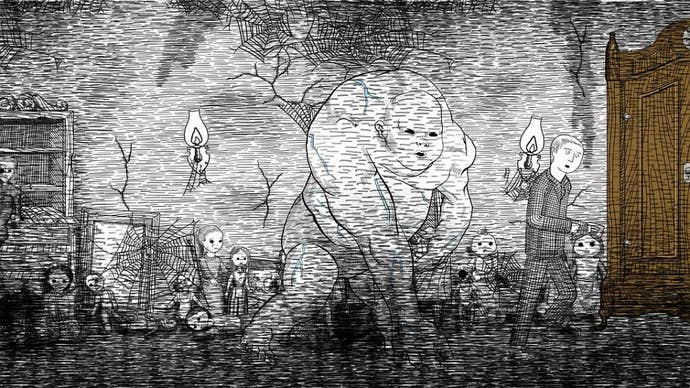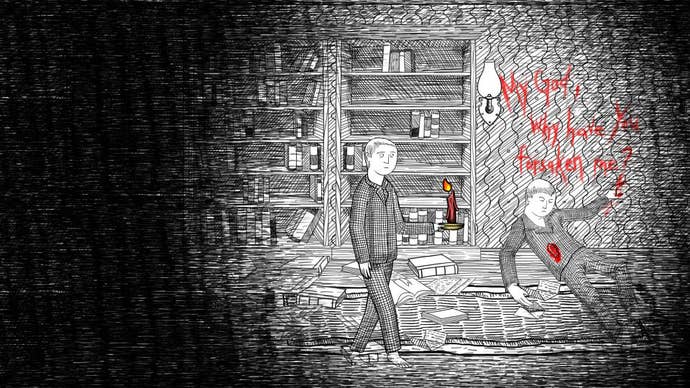Neverending Nightmares PS4 Review: Haunted and Hunted
Infinitap Games' deeply personal horror story makes for one of the best expressions of the genre.
This article first appeared on USgamer, a partner publication of VG247. Some content, such as this article, has been migrated to VG247 for posterity after USgamer's closure - but it has not been edited or further vetted by the VG247 team.
No matter what petty differences separate us as human beings, ultimately, we're united by the common fears stirring around in our lizard brains: Those common, universal anxieties we can't escape from, despite the march of progress.
On that note, Infinitap Games' Neverending Nightmares—which originally released on the PC back in 2014—does exactly what its title implies: essentially, it's a nightmare simulator. And while it doesn't have the ability to tap into the extreme specifics of what causes each and every one of its players to spring out of bed in a cold sweat, Neverending Nightmares does a great job of evoking those broad, commonly featured themes that often pop up in our own nightmares: being pursued, trapped, and/or lost, suffering believable bodily harm, and falling.

Ultimately, the goal of Neverending Nightmares lies in escaping from the series of interconnected nightmares your protagonist finds himself trapped in. Infinitap's creation plays out like a standard side-scrolling game—depicted in a haunting style reminiscent of the artist Edward Gorey—with an extremely simple interface: you can walk, run, open doors, and interact with the very small amount of objects depicted in full color. Once you navigate through the labyrinthian architecture to find a way out, you're dropped into a new nightmare—usually with a new setting. Granted, it's a very simple game: one meant to evoke emotion rather than challenge your skills.
Of course, as with any good (bad) nightmare, you're not alone. After the opening introduces the basics, each nightmare to follow typically features a unique antagonist that can kill you, swiftly and brutally, within a few seconds. But since your characters doesn't have many moves at his disposal, it only takes a few attempt to figure out the best way to avoid being murdered: you'll either have to hide, avoid their line of sight, or simply run the hell away. Thankfully, Neverending Nightmares is pretty forgiving about these enemy encounters, and provides a checkpoint before each one so you can immediately try out a new strategy after you die. It's a very smart move that prevents frustration from interfering with the sense of dread Neverending Nightmares strives for.
At its best, Neverending Nightmares feels a lot like the horror masterpiece Silent Hill 2. And though it doesn't have the same narrative drive as Konami's classic, it employs many of the same tricks. Of course, we have the general nightmare "logic" of your surroundings, where environments change and align in ways that don't quite make sense. But the more powerful moments in Neverending Nightmares come when the tedium of heading through hallway after repetitive hallway is punctuated by an unexpected surprise. I usually find jump-scares a pretty cheap device in horror games, but here, they're much more subtle, and actually come as a bit of a relief after a long buildup of dread. Neverending Nightmares goes out of its way to earn these shocking moments, and I really appreciate that.

Recommending Neverending Nightmares comes with a bit of a caveat, though, as it touches on some subjects that may be disturbing to players who've dealt with them personally. Both suicide and self-harm exist as major themes throughout, meaning depictions of these acts pop up semi-frequently. To Neverending Nightmares' credit, these moment feel sincere and earned, rather than cynically calculated for maximum shock value, which helps make them even more effective. Of course, it helps to know that Neverending Nightmares' creator Matt Gilgenbach created the game to deal with and express his own mental health issues, so his attempts to wrangle with this subject matter come from a very real place. Still, the depictions may be a little too intense for some, even if Gilgenbach keeps them incredibly brief.
Neverending Nightmares may be a short experience, but everything wraps up just as the premise is fully explored. And, to be honest, drawing things out for more than a few hours would cause Neverending Nightmares to be a little too emotionally exhausting—as it stands, the finale comes just as the oppressive world runs the risk of growing too oppressive. Neverending Nightmares will only take up an afternoon of your life, but I guarantee it'll be a memorable one.
InterfaceThe extremely simple controls don't interfere with exploring these nightmare worlds.
Lasting AppealWhile future playthroughs offer access to different branching pathways, some of those scares and shocking moments might not be as effective the second time around.
SoundThe excellent sound design does much to accentuate Neverending Nightmares' sense of pervasive dread.
VisualsNeverending Nightmare makes effective use of its Edward Gorey-inspired art style to make its depictions of everyday environments subtly otherworldly and sinister.
ConclusionWith Neverending Nightmares, Infinitap does a stellar job of simulating the more common elements of nightmares, but shows enough self-control to prevent the experience from being absolutely wearying. Though the subject matter might be disturbing to some, this short, effective experience makes for one of the more memorable horror games in recent memory.


